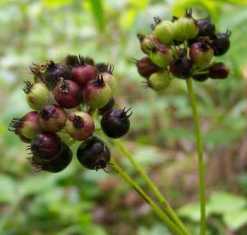Wild Sarsaparilla
 |
DescriptionWild sarsaparilla (Aralia nudicaulis L., Araliaceae) is a member of the ginseng family. It is a perennial herb with a single leaf stalk 30 - 60 cm tall that divides into 3 stems, each with 3 - 5 oval, pointed toothed leaflets. Flowers are small and greenish, in 3 umbels on a separate flowering stem. The fruit is a dark purple-black berry. |
History And Use
The root of wild sarsaparilla was used by North American First Nations people to make a bitter tea that was used to treat heart pain, stomach upset, toothache and sore throats. It was applied externally to prevent and treat infections. The whole plant was used to treat pneumonia, and the fruiting stalk to stimulate lactation. It is used today by herbalists as a substitute for true sarsaparilla, the totally unrelated plant Smilax spp. (Liliaceae) as a blood purifier and tonic. It is also being promoted as tonic because of its botanical relationship to ginseng, although there is very little chemical or pharmacological evidence to support such a use.
Area Of Adaptation
Wild sarsaparilla is very common in shaded mixed woods, in rich soil with lots of decaying plant material. It is found across Canada from coast to coast, and as far north in Manitoba as Reindeer Lake.
Cultivation And Processing
Harvesting is traditionally done by hand, taking only the main root of mature plants. The secondary root is left to propagate. The roots are washed and dried on racks, then stored on racks in a dark, dry, well ventilated area until they are chipped or ground.
Marketing
The market is very limited at the present, with all of the material supplied by wildcrafters. It is often substituted for Smilax sp., which is used in candies, baked goods and beverages. The closely related spikenard (Aralia racemosa L.), also native to southern Manitoba, is sold in several Health Canada-registered homeopathic liquid and tablet products.
